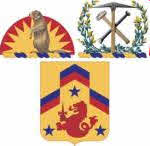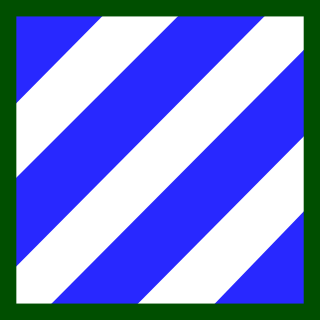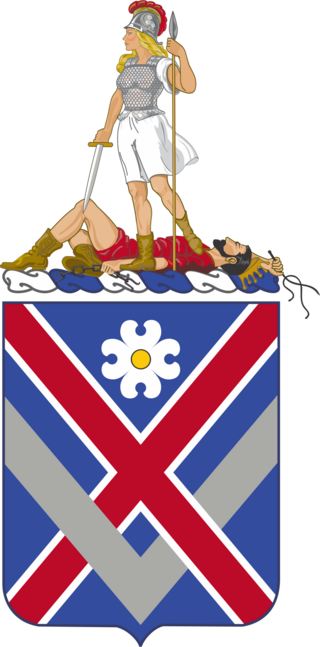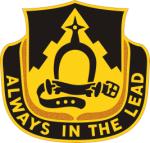
The 9th Cavalry Regiment is a parent cavalry regiment of the United States Army. It is not related to the 9th Kansas Cavalry Regiment of the Union Army. Historically, it was one of the Army's four segregated African-American regiments and was part of what was known as the Buffalo Soldiers. The regiment saw combat during the Indian and Spanish–American Wars. During Westward Expansion, the regiment provided escort for the early western settlers and maintained peace on the American frontier.
The 113th Cavalry Regiment is a cavalry regiment of the Iowa National Guard, with history tracing back to the 19th century Indian Wars.

The 58th Expeditionary Military Intelligence Brigade is a military intelligence brigade of the United States Army National Guard in Maryland. It was largely formed from the personnel and equipment of the 58th Battlefield Surveillance Brigade and officially stood up in its present configuration on 1 August 2015. Most recently, members of the brigade joined state efforts to contain the spread of COVID-19 in Maryland and constituted one of the last U.S. Army National Guard units to serve in the War in Afghanistan, returning to Maryland in February, 2021.

The 112th Infantry Regiment, also known as the Sixteenth Pennsylvania, is a unit in the Pennsylvania National Guard which can trace its lineage back to before the American Civil War.

The 82nd Cavalry Regiment is a parent regiment in the United States Army National Guard. It is represented in the Oregon Army National Guard by the 1st Squadron, 82nd Cavalry, part of the 81st Stryker Brigade Combat Team.

The 108th Cavalry Regiment is a cavalry regiment of the Georgia and Louisiana Army National Guards of the United States Army.

The 238th Cavalry Regiment was a United States Army parent cavalry regiment, represented in the Indiana Army National Guard by Troop E, 238th Cavalry, part of the 76th Infantry Brigade Combat Team, stationed at Bluffton.

The 48th Infantry Brigade Combat Team is a modular infantry brigade of the Georgia Army National Guard. One of the oldest units in U.S. Army history, the lineage of the 48th Infantry Brigade can be traced back to 1825. It is one of few units in the US military that also saw service as a unit of the Confederate States of America during the American Civil War. Today, the 48th IBCT is part of the U.S. Army's "Associated Units" program where it's aligned under the 3rd Infantry Division, a combined arms combat maneuver unit of the Regular Army.
The 150th Cavalry Regiment is a regiment of the West Virginia Army National Guard, with troops in multiple locations throughout West Virginia and one troop in Sanford, North Carolina. It was originally formed as Greenbrier County militia, fighting for Virginia in the American Revolutionary War. During the American Civil War, companies of the regiment loyal to the recognized Union state government in Wheeling were later combined to form the Union Army's 5th and 9th West Virginia Infantry regiments, aiding in the defeat of Confederate troops in West Virginia, Ohio and Virginia.

The 107th Cavalry Regiment, Ohio Army National Guard, is a parent regiment under the U.S. Army Regimental System, with headquarters at Hamilton, Ohio. It currently consists of the 2nd Squadron, 107th Cavalry Regiment, part of the 37th Infantry Brigade Combat Team (BUCKEYE), Ohio National Guard located throughout southwest Ohio.

The 102nd Cavalry Regiment is a regiment of the United States Army first established in 1913 and which saw service in World War II.

The 104th Cavalry Regiment is a Regiment of the United States Army first established in 1921. Troop A, 1st Squadron is one of several National Guard units with colonial roots and campaign credit for the War of 1812.

The Tennessee Army National Guard is a component of the United States Army and the United States National Guard. Nationwide, the Army National Guard comprises approximately one half of the US Army's available combat forces and approximately one third of its support organization. National coordination of various state National Guard units are maintained through the National Guard Bureau.
The 105th Cavalry Regiment is a regiment in the United States Army National Guard.

The 1st Squadron, 180th Cavalry Regiment is a formation of the United States Army, headquartered in McAlester, Oklahoma. It is a part of the 45th Infantry Brigade Combat Team, Oklahoma Army National Guard and is one of the oldest units in the brigade.

The 134th Cavalry Regiment is a cavalry regiment in the Nebraska Army National Guard. By extension, it is a member of the United States Army National Guard, and as a currently federally-recognized unit, also a member of the National Guard of the United States.

First Squadron, 153rd Cavalry Regiment "Darkhorse" is an element of the Florida Army National Guard, headquartered in Panama City, Florida with units throughout the Panhandle. It was formerly 3rd Battalion, 124th Infantry and officially converted to cavalry on 1 September 2007 when the 53rd Infantry Brigade converted from a "separate brigade" to the brigade combat team structure.

The 183rd Cavalry Regiment is a cavalry regiment of the United States Army, Virginia Army National Guard. The 183rd Cavalry was established as the 183rd Infantry Regiment and was reflagged as a cavalry regiment in 2006. It provides all armored and cavalry assets for the Virginia National Guard, fielding the M1 Abrams, Bradley Fighting Vehicle, and Humvee.

The 303rd Cavalry Regiment is a United States cavalry regiment, currently represented in the Washington Army National Guard by the 1st Squadron, 303rd Cavalry, headquartered at Vancouver, Washington, part of the 96th Troop Command. It incorporates the lineage of the 303rd Cavalry, 303rd Armor, and 803rd Armor Regiments of the Washington Army National Guard.

The 110th Cavalry is an inactive parent cavalry regiment of the United States Army National Guard. Constituted as the 26th Cavalry under the Combat Arms Regimental System in 1963, its 1st Squadron served with the 26th Infantry Division during the Cold War. It was renumbered in 1988 as the 110th and reorganized under the United States Army Regimental System in 1988 before the 1st Squadron inactivated in 1996 as a result of reductions in the National Guard after the end of the Cold War.



















